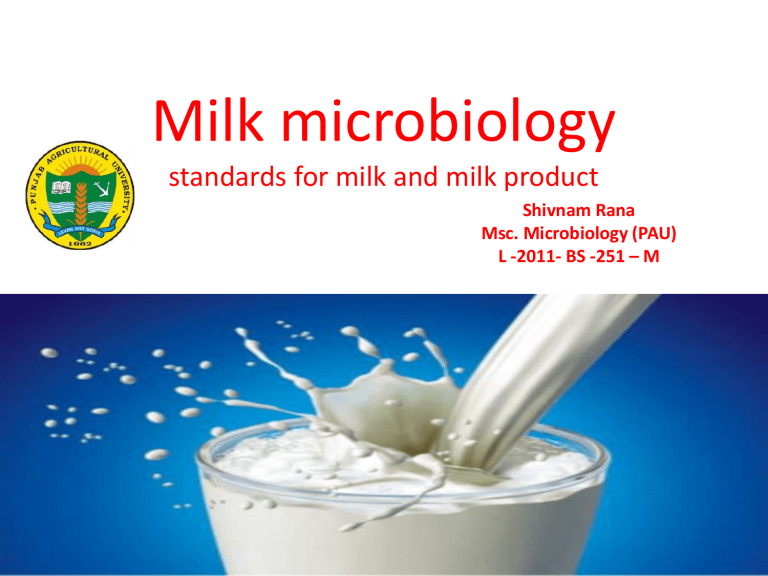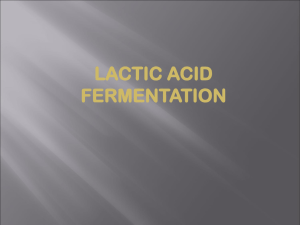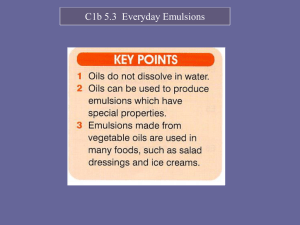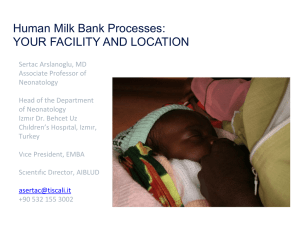Milk microbiology- standards of milk and milk product

Milk microbiology
standards for milk and milk product
Shivnam Rana
Msc. Microbiology (PAU)
L -2011- BS -251 – M
Introduction
• Complete food – Carbohydrates(Lactase),
Protein(Casein), Fats, Minerals
• due to: Complex biochemical composition
High water activity
• Excellent culture medium for the growth and multiplication of microorganisms
Factors that influence survival and growth of microorganisms
Intrinsic
• Nutrient availability
• pH
• Water availability
Extrinsic
• Temperature
• Atmosphere
Origin of microorganism in milk
• Commensal micro flora- teat skin, epithelial lining of the teat canal, duct that conveys the milk from the mammary gland to the teat orifice.
Staphylococcus, Streptococcus,Bacillus, Micrococcus,
Corynebacterium, coliforms
• Environmental contamination- soil, water equipment, dairy farm area are reservoir for many food borne pathogens
Salmonella species,
L. monocytogenes
• Diseased animal
Mastitis- Staphylococcus (S.agalactiae) and
Streptococcus species
Lactobacillus
• Obligate homofermentative lactobacillus – hexoses ferment lactic acid
• Growth at 45°C but not at 15°C
• Lactobacillus delbrueckii, lactobacillus helveticus,
lactobacillus salivarius and L. Acidophilus
• Facultative homofermentative lactobacillushexoses ferment lactic acid or glucose limitation acetic acid, ethanol, formic acid
• Grow at 15°C and show variable growth at
45°C
• Lactobacillus casei, lactobacillus curvatus, lactobacillus sakei and lactobacillus plantarum.
• Obligate heterofermentative lactobacillus-
Hexoses ferment lactic acid+ acetic acid+ ethanol+ CO2 pentoses ferment lactic acid + acetic acid
• Lactobacillus fermentum, lactobacillus brevis and lactobacillus keferi.
Benefit
• Resist weak acids of ph 3.5 to 4.5 resulting to a yield of 90% lactic acid.
• Starter culture.
• Preservative for the production of cheese and yoghurt.
Lactobacillus acidophilus
• Absorb B vitamins, vitamin K, fatty acids and calcium.
• Reduce lactose intolerance.
• Increases the production of anti-allergy cytokines, chemical messengers released by cells of the immune system.
Lactobacillus bulgaricus
• Helps reduce symptoms of lactose intolerance.
• Provides the stomach and intestine with the enzyme bacterial lactase that helps digest the lactose in milk.
Enterococci
• Ubiquitous gram-positive, catalase-negative
• Ability to survive extreme ph, temperatures, and salinity.
• Psychrotrophic nature, heat resistance and adaptability to different substrates and growth conditions
• Enterococci also occur in natural milk (or whey) starter cultures
• Made by incubating it at 42–44 °C for 12–15 h
• Used for manufacturing of cheese ( artisan)
• Strains E. Faecalis and E. Faecium producing enterocins
• Activity against listeria monocytogenes,
staphylococcus aureus, clostridium spp.,
Including clostridium botulinum and
clostridium perfringens, and vibrio cholerae
Bifidobacterium bifidum
• Optimum growth ph 6- 7.0
• Optimum growth temperature 37- 41°C, maximum 43- 45°C, minimum 25- 28°C
• Produce acetic acid, lactic acid- 3:2
• Helping in digestion
• Strengthens the immune system
• To eliminate harmful bacteria
Lactobacillus rhamnosus
• Lactose-intolerant people to reduce the inflammatory response that occurs when they consume milk.
• Helps the immune system by stimulating the production of antibodies and combating pathogenic bacteria.
Lactose and galactose utilization by different lactic acid bacteria
Lactobacillus curd
• Milk is heated to a temperature of 30-40 °C
• Complex and heterogenous flora - L. Lactis , L.
Lactis subsp cremoris , S. Thermophilus , L.
Debrueckii subsp bulgaricus , L. Plantarum and lactose fermenting yeast.
• Anaerobic respiration
Special attribute of Curd
• Dysentery and other gastrointestinal disorders.
• Improve appetite , vitality and increase digestibility.
yogurt
• Mixed starter culture – S. Thermophilus and lactobacillus delbrueckii or lactobacillus bulgaricus.
• Ratio 1:1
• Fermentation :- lactose content of milk to yield lactic acid, CO2, acetic acid, diacetyl, acetaldehyde
• Ph reduces :- around 6.5 to 4.5 due to the production of organic acids
• Initially streptococcus thermophilus ferments the lactose
• Lactobacillus bulgaricus, which is more acid tolerant, continues to ferment the remaining lactose.
Lactase
Lactose glucose + galactose
Hydrolyzes
Benefit
• Easier digestibility,
• The ingested organisms enhance bioavailability of nutrients
• Ensure gastrointestinal balance,
• Promoting colon health
• Accelerates the healing of gastrointestinal tract disorder
• Reduction in cholesterol level.
Cheese
Different cheese using different strains
• Swiss cheese formation involves a late propionic acid fermentation with ripening done by Propioni bacteria shermanii.
• Blue cheeses are produced by Penicillium spp.
• Roquefort cheese is produced by using P. roqueforti
• Camembert and Brie by using P. camemberti and P. candidum .
Pathway for Citrate – positive strain of lactococcus and leuconostoc species
Changes in milk by microorganism
Gas production:
• Fermentation occurs at faster rate, then raw milk present a foamy layer on the upper surface
• Air bubbles becomes entrapped and gas becomes saturated throughout the body of the milk
• Colliforms, clostridium and bacillus species.
Proteolysis
• Acid Proteolysis:
Milk whey separated, Milk taste will be soured, Micrococcus sp.
• Alkaline Proteolysis:
Milk whey separated and pH >6.9 (towards neutral and alkaline). Milk taste will be bitter
• Sweet curdling:
Bacillus cerus – it release enzymes “ protease ” which targets the casein. Bacteria use lactose and convert into acids and aldehyde components. Milk is sweet in taste
• Slow Proteolysis:
Release of endogenous proteases in the milk, cause slow proteolysis of the milk.
• Proteolysis due to Anaerobic Bacteria:
Bacillus and clostridial species are heat resistant. result into specific kind of smell names as butyrine smell
• Roppiness or sliminess
:
Milk viscosity is increased, rope like structure is formed
Alcaligenes viscolactis
• Change in the color of milk:
Blue color ------------------------ pseudomonas synciani
Red color ------------------------brubibacterium erythrogenes , sarcinia marcense
Yellow color --------------------- pseudomonas synxantha
Brown color --------------------pseudomonas putrificians
Green color ---------------------- pseudomonas aurogenosa
Changes in Milk Fat
• Oxidation of unsaturated fatty acids:
Milk fat oxidation aldehydes + ketones + acids
• Oxidation imparts tallowy odors
• Hydrolysis of overall milk fat: lipase
Fatty acids glycerols + free fatty acids
Hydrolysis
• Gives rise to putrefied odor ( rotten egg like smell)
• Combined hydrolysis and oxidation eg:Proteus, Alcaligenes, Micrococcus
Change in the Flavor of Milk
Sour Flavour:
It is due to acidic changes in the milks:
Clean : Low contents of acids, Streptococcus lactis
Aromatic : streptococci and aroma- forming Leuconostoc sp. , moderated type of acidic components.
Sharp : coliform bacteria, clostridium species, volatile fatty acids, high acidic contents
• Bitter Flavour:
It is due to alkaline changes in the milk.
• Potato-like Flavour:
Pseudomonas mucidolense
• Fishiness:
Acromian hydrophila, It is due to formation of tri-methyl amine
Polymerase chain reaction denaturing gradient gel electrophoresis (PCR-DGGE)
Fluorescent in situ hybridization(FISH)
ELISA
Prevention method
• Pasteurization
• Ultra-High Temperature- 138 °C to 150 °C for 4 to 15 seconds
• Steam under pressure- 115 to 118°C for 14 to 18 min, caned milk
• Radiation- gamma, UV rays
• Preservatives- sorbic acid, propionic acid, sugar, salt, hydrogen peroxide
• Modified atmosphere packaging
• Refrigeration - 10 °C or low temperature
• Freezing17 to -18 °C
HACCP
Principle 1: Conduct a hazard analysis.
Principle 2: Determine the Critical Control Points
(CCPs).
Principle 3: Establish critical limit(s).
Principle 4: Establish a system to monitor control of the CCP.
Principle 5: Establish the corrective action to be taken when monitoring indicates that a particular CCP is not under control.
Principle 6: Establish procedures for verification to confirm that the HACCP system is working effectively.
Principle 7: Establish documentation concerning all procedures and records appropriate to these principles and their application.
New bacteria discovered in raw milk
• Chryseobacterium oranimense, which can grow at cold temperatures(7°C) and secretes enzymes that have the potential to spoil milk.“
• C. haifense and C. bovis
laws
• Milk and milk product order, 1992
• Milk and milk product amendment regulation,
2009
Precautions
• The animal should be healthy and free from diseases.
• A healthy person should milk the animals. He should avoid sneezing, coughing, etc., and must wear clean clothes.
• Milking vessels should be cleaned properly with chemicals or detergents that are not injurious to health.
• Arrangements must be made in advance to immediately cool the milk to 4 ºC within an hour of milking.
• The ingredients and cleaning agents used must be of the desired quality.
• There should be a provision for checking the quality, sampling and testing of milk.
Reference
• Beresford T P, Fitzsimons N A, Brennan N L and Cogan T M (2001) Recent advances in cheese microbiology. International Dairy Journal 11 259–74.
• Ledenbach L H and Marshall R T 2009 Microbiological Spoilage of Dairy Products.
Compendium of the Microbiological Spoilage of Foods and Beverages 1-4419
• Nwamaka N T and Chike A E (2010) Bacteria population of some commercially prepared Yoghurt sold in Enugu State, Eastern Nigeria. African Journal of
Microbiology Research 4 (10) 984-88.
• Papademas P and Bintsis T (2010) Food safety management systems (FSMS) in the dairy industry: A review International Journal of Dairy Technology 63 14-07.
• Varga L (2007) Microbiological quality of commercial dairy products.
Communicating Current Research and Educational Topics and Trends in Applied
Microbiology








